


 Grammar
Grammar
 Tenses
Tenses
 Present
Present
 Past
Past
 Future
Future
 Parts Of Speech
Parts Of Speech
 Nouns
Nouns
 Verbs
Verbs
 Adverbs
Adverbs
 Adjectives
Adjectives
 Pronouns
Pronouns
 Pre Position
Pre Position
 Preposition by function
Preposition by function 
 Preposition by construction
Preposition by construction
 Conjunctions
Conjunctions
 Interjections
Interjections
 Grammar Rules
Grammar Rules
 Linguistics
Linguistics
 Semantics
Semantics
 Pragmatics
Pragmatics
 Reading Comprehension
Reading Comprehension|
Read More
Date: 2024-01-06
Date: 7-3-2022
Date: 2024-01-23
|
Japanese adjectival morphology
The Ezafe construction and the general approach to DP structure pursued here suggest many intriguing connections, of which we will sketch just one. The Indo-Iranian language Zazaki exhibits the Ezafe construction in a significantly more complex form than Modern Persian. Whereas Ezafe is invariant (up to phonological alternation) in Persian, in Zazaki the Ezafe element inflects according to the number (sg/pl) and the gender (masc/fem) of the modified noun. Furthermore, and more importantly for our purposes, Zazaki distinguishes between a descriptive Ezafe, which links a modified noun with an adjective, and a genitive Ezafe, which links a noun to another noun in the possessive relation. Table 1 gives the set of Zazaki Ezafe forms, drawn from Todd (1985).1 Examples are provided in (1–2) also from Todd (1985).
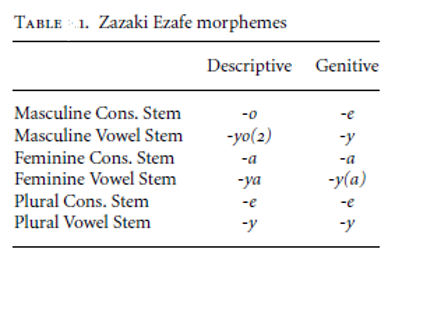
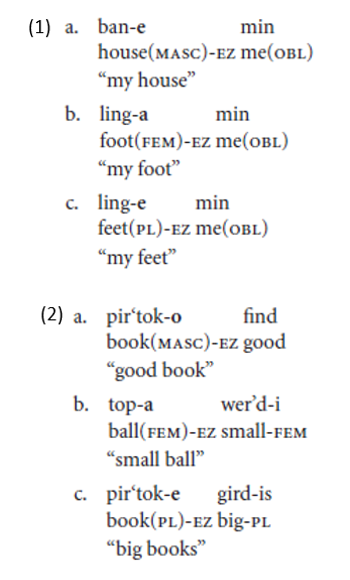
Under the view of Ezafe as a Case-marker, this suggests that Zazaki distinguishes at least two cases within the nominal: one with which it marks NP/DP modifiers in a genitive relation N (1), and a second that it uses for adjectival modifiers in a descriptive relation (2).
Given this result, it is interesting to observe that Japanese appears to make a very similar distinction in its system of marking for prenominal modifiers. Japanese contains a morpheme -no that is used to link a noun with an NP/DP in a genitive or modifying relation (3a–c).
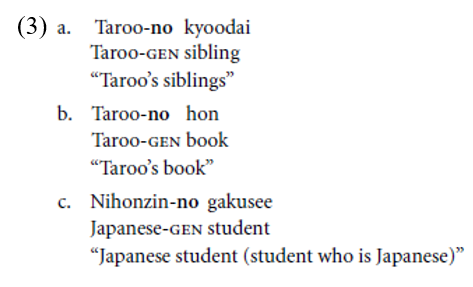
In addition, Japanese contains morphemes that are used to link a noun with an attributive AP, an AP in a descriptive/modifying relation. There are in fact two such morphemes, -i and -na, corresponding to the two classes of Japanese adjectives, so-called “true adjectives” (4a, b) and “nominal adjectives” (4c, d).
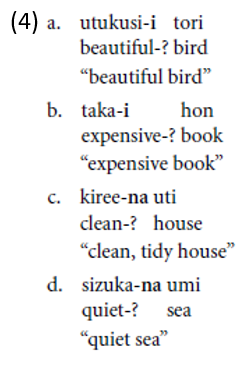
While the morpheme -no in (3) is standardly classified in Japanese grammar books as a genitive case-marker, the status of -i and -na has been much more controversial. A large number of linguists have assumed that these morphemes represent tenses, copulas, or tensed forms of the copula, implying that (4a–d) all represent covert relative clause constructions (5a–d).
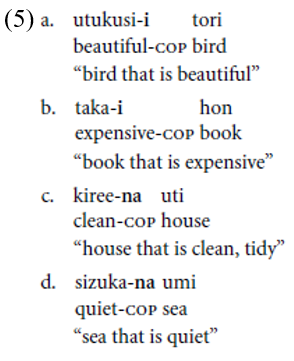
However, Yamakido (2000, 2005, 2007) argues convincingly that the relative clause analysis cannot be correct. One simple piece of evidence is the existence of non-predicating Japanese AP constructions like (6a, b).
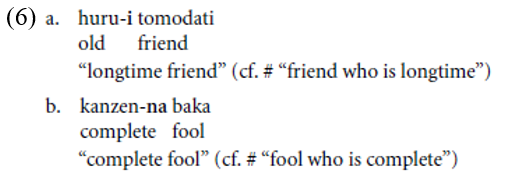
If the adjectival linking morphemes are not tenses, copulas, or tensed copulas, then what are they? Yamakido (2005) argues that these elements are in fact case morphology. Hence if she is correct, then not only do -no, -i, and -na form a set, their pattern (abstracting from number and gender) is essentially identical to that of Zazaki: -no represents the Japanese genitive Ezafe morpheme used to link a noun with a modifying NP/DP in a possessive relation, and -i/-na represents the Ezafe morpheme used to link a noun with a modifying AP in a descriptive relation.
1 Table 1 leaves out what Todd labels the subordinated Ezafe series, which occur in the context of certain oblique case environments. That Ezafe alternates in this circumstance again suggests that it is a form of case-marking. See Larson and Yamakido (2005) for more on subordinated Ezafe.
|
|
|
|
التوتر والسرطان.. علماء يحذرون من "صلة خطيرة"
|
|
|
|
|
|
|
مرآة السيارة: مدى دقة عكسها للصورة الصحيحة
|
|
|
|
|
|
|
نحو شراكة وطنية متكاملة.. الأمين العام للعتبة الحسينية يبحث مع وكيل وزارة الخارجية آفاق التعاون المؤسسي
|
|
|